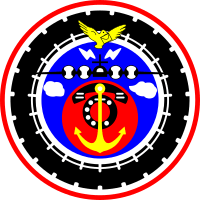Ministry of Transportation and Communications (Taiwan)
|
中華民國交通部 Jiāotōngbù | |
|
Logo | |
 | |
| Agency overview | |
|---|---|
| Formed | January 1912 |
| Jurisdiction |
|
| Headquarters | Zhongzheng, Taipei |
| Ministers responsible |
|
| Parent agency | Executive Yuan |
| Website | www.motc.gov.tw |
The Ministry of Transportation and Communications of the Republic of China (MOTC; Chinese: 中華民國交通部; pinyin: Zhōnghuá Mínguó Jiāotōngbù) is a cabinet-level governmental body of the Republic of China in charge of all policy and regulation of transportation and communications networks and administration of all transportation and communications operations and enterprises in Taiwan.
Introduction
In Taiwan, transportation and communications operations comprise four categories: communications, transportation, meteorology, and tourism. The Ministry of Transportation and Communications is responsible for making policy, formulating laws and regulations, and overseeing operations in the area of transportation and communications.
Communications operations encompass postal services and telecommunications. Postal services are managed by the Taiwan Post Co., Ltd. In regard to telecommunications, the MOTC is responsible for overall planning of communications resources, assisting and promoting the communications industry, and fostering universal access to communications.
Transportation operations are divided into land, sea, and air transportation.
Land transportation comprises railways (including conventional railway, mass rapid transit, and high-speed rail) as well as highway transportation. Conventional railway is planned and sponsored by the Taiwan Railways Administration and Railway Reconstruction Bureau. Mass rapid transit systems are managed by the Bureau of High Speed Rail, Taipei City Government and Kaohsiung City Government. High-speed rail is managed by the Bureau of High Speed Rail. Highway transportation is managed by the Directorate General of Highways, Taipei City Government, and Kaohsiung City Government. Expressways are constructed by the National Expressway Engineering Bureau, and managed and maintained by the National Expressway Bureau under this ministry, respectively.
Sea transportation consists of water transport and harbors. Shipping carriers of water transport are privately operated, while all harbors are operated by the various harbor bureaus under this ministry.
Air transportation includes airline companies and airports. Airline companies are privately operated, while airports and flight navigation services are operated by the Civil Aeronautics Administration under this ministry.
Also the Central Weather Bureau under this ministry handles all national meteorological operations.
And the Tourism Bureau under this ministry provides planning and oversight for tourism development.
Organization
The administrators of MOTC include the Minister, Executive Vice Minister and two Administrative Deputy Ministers.
MOTC is divided into Internal Division and External Division.
Internal Division
Secretariat, Office of Technical Superintendents, Office of Counselors, Department of General Affairs, Department of Personnel, Department of Civil Service Ethics, Department of Accounting, Department of Statistics, Legal Affairs Committee, Petition Reviewing Committee, Road Traffic Safety Committee, Office of Science and Technology Advisors, Information Management Center, Transportation Mobilization Committee, Department of Railways and Highways, Department of Posts and Telecommunications, Department of Navigation and Aviation, Transportation and Communications Management Unit.[1]
External Division
- Taiwan Area National Freeway Bureau
- Civil Aeronautics Administration
- Taiwan Area National Expressway Engineering Bureau
- Tourism Bureau
- Directorate General of Highways
- Central Weather Bureau
- Railway Reconstruction Bureau
- Maritime and Port Bureau
- Bureau of Taiwan High Speed Rail
- Institute of Transportation
- Chunghwa Post Co., Ltd.
- Taiwan Railways Administration
- Taoyuan International Airport Corporation
- Taiwan International Ports Corporation
List of Ministers

- Wang Boqun (1927 – 1931)
- Chen Mingshu (December 1931 – October 1932)
- Huang Shaohong (July 1932 – December 1935)
- Chu Chia-hua (October 1932 – December 1935)
- Yu Feipeng (1935) (acting)
- Ku Meng-yu (1935 – 1937)
- Yu Feipeng (March 1937 – 1938)
- Chang Kia-ngau (1938 – 1942)
- Zeng Yangfu (December 1942 – February 1945)
- Yu Feipeng (February 1945 – May 1946)
- Yu Dawei (May 1946 – February 1949)
- Ling Hongxun (February 1949 – March 1949) (acting)
- Duan Mujie (March 1949 – February 1950)
- Yan Xishan (December 1949 – February 1950) (acting)
- Chen Liang (February 1950 – March 1950)
- He Zhong-han (March 1950 – June 1954)
- Yuan Shou-chien (June 1954 – July 1960)
- Shen Yi (July 1960 – December 1967)
- Sun Yun-suan (December 1967 – October 1969)
- Chang Duan-cheng (October 1969 – May 1972)
- Kao Yu-shu (June 1972 – June 1976)
- Lin Chin-sheng (June 1976 – December 1981)
- Lien Chan (December 1981 – April 1987)
- Kuo Nan-hung (May 1987 – 1989)
- Ma Cheng-fang (1989 – 1991) (acting)
- Clement C.P. Chang (1 June 1991 – 24 April 1991)[2]
- Eugene Chien (June 1991 – February 1993)
- Liu Chao-shiuan (February 1993 – June 1996)
- Tsay Jaw-yang (June 1996 – March 1998)
- Lin Fong-cheng (April 1998 – May 2000)
- Yeh Chu-lan (May 2000 – February 2002)
- Lin Ling-san (February 2002 – January 2006)
- Kuo Yao-chi (January 2006 – August 2006)
- Tsai Duei (August 2006 – May 2008)
- Mao Chi-kuo (May 2008 – February 2013)
- Yeh Kuang-shih (February 2013 – January 2015)
- Chen Jian-yu (January 2015 – May 2016)
- Hochen Tan (May 2016 –) (incumbent)
Transportation
The MOTC building is accessible by walking distance North West of Dongmen Station of the Taipei Metro on the Red Line.[3]
See also
| Wikimedia Commons has media related to Ministry of Transportation and Communications (Republic of China). |
References
- ↑ "Organization - Ministry Of Transportation And Communications R.O.C". Motc.gov.tw. Retrieved 2014-05-07.
- ↑ http://www.taiwantoday.tw/ct.asp?xItem=11944&CtNode=122
- ↑ "交通部 - Google Maps". Maps.google.com. 2013-02-28. Retrieved 2014-05-07.
External links
- Ministry of Transportation and Communications (Taiwanese Mandarin)




